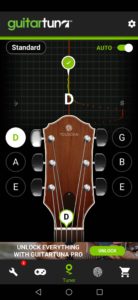I Help people sing and speak expressively and powerfully no matter the level of experience :)
HI, I'M JORGELINA
EXPAND YOUR VOCAL RANGE TODAY!
Grab today my 3 SINGING SECRETS to expand your vocal range for FREE!
GRAB IT NOW

How to sing in tune when you were told you are “tone deaf”
“How to sing in tune” is a very hot topic for those who want to get started in singing but are terrifying of doing it.
A lot of people are told by well-intentioned relatives and friends that they cannot sing, or even worse, that they are “tone deaf” and that they will never be able to sing. These statements, which could be made as simple jokes, have enormous consequences for those who believe them.
The truth is that most of the time, people that make these statements don’t even know what being tone-deaf means.
The term tone-deaf is reserved for those who are unable to identify different pitches.
However, in over 10 years of teaching, I haven’t had one single student that is actually tone-deaf. There are some that have difficulty singing in tune at first, but in my experience teaching, all of them eventually learn to sing in tune.
There are two kinds of people that talk about themselves as tone-deaf. There are those who cannot currently sing in tune, but they can hear it. And then there are those who don’t sing in tune and cannot tell. This post is about the last group, and for the sake of the article, I’m going to assume that you know nothing at all about music.
How to sing in tune: What to do if you’re told you’re “tone deaf”
First of all, identify who planted that belief in your mind. Then, observe if that person has music knowledge of any kind or not. If not, then discard immediately their opinion. Remember that opinions from specific persons are just opinions and not an absolute truth, no matter who that person is.
If you think you’re tone-deaf, find a friend that actually knows music. Not only likes listening to music, but can actually play an instrument.
Then ask them to help you check if you can sing in tune or not, not by singing a song, but at first just by singing one single note.
If they have their instrument with them, ask them to play a note that is in your comfortable range (Probably C3 to F3 if you’re a male, and C4 to F4 if you are a female, will work OK). Then try to match the note by singing a long AHH. They will be able to tell you if you are in tune or not.
What if you don’t know anybody that knows music, and you cannot afford a music lesson?
Well, in that case knowing how to sing in tune gets a little bit more difficult but there are still some things you can do.
You can download a tuner app on your phone. Tuners are used to tune instruments such as guitar. I use Guitar Tuna, but there are lots of them and you can get them for free.
This is how Guitar Tuna screen looks like.

As you can see there are letters D A E G B on the screen, they are there to help you tune your guitar but we are going to use them for other purposes.
How to use a Guitar Tuner to find out if you’re actually tone-deaf or not
- Download the app ????
- Find an online keyboard, such as virtualpiano.net
- Play D note. If you have no idea where it is, just play the 9th white note from left to right (D3) if you are a male, and the 16th white note (D4) if you’re a female). Play it and keep the app open near the speaker. The app should look like this, indicating that you’re playing the right note.

- Next, proceed to sing the same note near the tuner. If you’re in tune, you should see the same letter D in the center of the line. If the same note appears, then you’re singing in tune, even if it is a little bit sharper or flat. That means you can identify a particular pitch and reproduce it with your voice. If the note is a little bit sharp or flat, you can work on that easily.
What if I cannot reproduce the same pitch at all?
If you are playing a D and then when you sing the app shows you a note that is nothing like that, for example, a G, then you have to work a little to tune your voice. It still doesn’t mean that you are tone-deaf, since lots of students with the same issue have resolved it with practice.
So if that is your case, prepare yourself to be patient and open to the process, because the process of opening your ears requires transformation
How can I open my ears?
Well, to start with, we not only listen with our ears but rather with our whole body.
A simple exercise you can try:
- Sit comfortably in a position that allows your body to relax.
- Close your eyes
- Relax your breath
- Listen to a single note. You can ask someone to play a note in the piano for you, or you can play a track like this:
- Listen to the note with your whole body, and pay attention to the vibrations that it produces. Every note vibrates in a particular frequency, so it is useful to concentrate on that at the beginning.
- Once you have found the particular feeling of that note, sing the note that you are hearing, and feel if the frequency that you are singing feels like it.
- Pause whenever you need to rest and try again. Take all the time you need to sing the note until you feel that you are “in tune” with it. Listen and record yourself. Then listen to the recording and try to identify if you are singing the same note or not. If you are still unable to tell, ask for the help of a friend that can play music.
This exercise has worked for all the students I have had that thought of themselves as “tone deaf”, with no exception. The moment they could sing the note in tune they knew it because it just felt right.
It is about connection and allowing the sound to flow through you. When you are starting, it doesn’t matter if you spend 20 minutes or more with a single note, that can well be a form of meditation actually! The more you practice, the easier it will become and soon you will be able to sing not only single notes but entire songs.
If you’re interested in learning one on one, you can take singing lessons in Auckland (North Shore area), and online from wherever you are!
- Singing lessons for adults in Auckland (North Shore) and online singing lessons for adults
- Singing lessons for teenagers and kids (9+ years old) – Auckland (North shore)
- Singing group classes for adults in Auckland – North Shore area (Unsworth Heights)
- For online holistic singing programs visit https://holisticvoiceacademy.com
I help people to develop their voice and singing from a holistic approach. I teach vocal lessons in person in Auckland, NZ, and online. Also stay tuned for my new online singing programs!❤️
My greatest passion has always been the voice, music and energy arts.
My personal and artistic journey has led me to understand that the voice and the body are fully connected, and that includes not only the physical body but also the mental, emotional and spiritual body.
Through holistic vocal training you not only learn to become a great singer while taking care of your voice, but you also improve your mental and physical wellbeing❤️
AUCKLAND CONTEMPORARY SINGING SCHOOL - COPYRIGHT 2024 ©
leave a comment